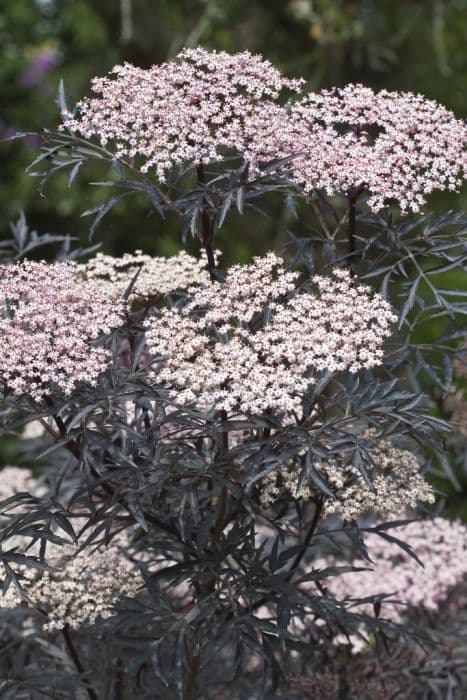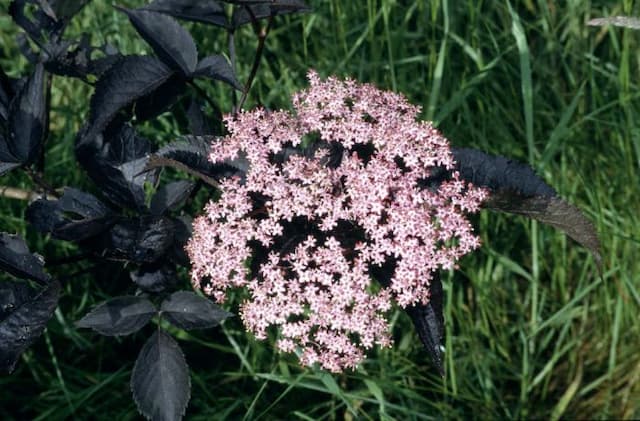David Viburnum Viburnum davidii

ABOUT
Viburnum davidii, commonly known as David viburnum, is a plant with a distinctive and attractive appearance. It is an evergreen shrub that features a symmetrical and mound-like shape with a dense, spreading habit. The leaves of the David viburnum are leathery in texture and deep green in color. They are oval to oblong in shape, with a somewhat elongated look and a noticeably veined appearance that provides a textured pattern on the leaf surface. This plant is known for its highly ornamental qualities, which include the glossy sheen of the leaves that catches the light, giving the plant a vibrant presence in garden settings. The edges of the leaves are slightly serrated or toothed, contributing to the overall textured look of the foliage. During the blooming period, the David viburnum produces clusters of small flowers. These blossoms are particularly noteworthy for their hue - typically a pale blue to white color - and they are arranged in small, rounded groups that add a decorative touch to the plant. When the flowers have finished blooming, they give way to berries that can be quite eye-catching. The fruit is usually a deep blue or turquoise color and adds a contrasting pop of color against the evergreen leaves. Overall, the David viburnum's appearance is characterized by its lush foliage, structured form, delicate flowers, and colorful berries, which all contribute to its popularity in ornamental horticulture.
About this plant
 Names
NamesFamily
Adoxaceae
Synonyms
David Viburnum, David's Viburnum
Common names
Viburnum davidii
 Toxicity
ToxicityTo humans
David viburnum is considered to have a low level of toxicity to humans. However, if ingested, parts of this plant can cause mild stomach upset. Symptoms of poisoning may include nausea, vomiting, and diarrhea. While not considered highly toxic, it is still advisable to avoid consuming any part of the David viburnum plant.
To pets
David viburnum is also known to have a low level of toxicity to pets like cats and dogs. If pets ingest parts of this plant, they might experience mild gastrointestinal upset, which could manifest as symptoms such as vomiting, diarrhea, or drooling. Although the toxicity is generally low, it is best to prevent pets from eating any part of the David viburnum plant to avoid these potential consequences.
 Characteristics
CharacteristicsLife cycle
Perennials
Foliage type
Evergreen
Color of leaves
Green
Flower color
White
Height
3 feet (0.91 meters)
Spread
3 feet (0.91 meters)
Plant type
Shrub
Hardiness zones
7
Native area
China
Benefits
 General Benefits
General Benefits- Ornamental Appeal: Viburnum davidii is known for its attractive, glossy evergreen leaves and metallic blue berries, making it a popular choice for ornamental gardens.
- Wildlife Attractor: The flowers provide nectar for pollinators, while the berries are a food source for birds, adding biodiversity to the garden.
- Low Maintenance: This plant is relatively easy to care for, requiring minimal pruning and able to tolerate a variety of soil conditions.
- Drought Tolerance: Once established, Viburnum davidii can withstand periods of dry weather, making it suitable for xeriscaping.
- Shade Tolerant: It can grow in partially shaded areas where other plants might struggle, allowing for versatile landscaping options.
- Privacy and Screening: With its dense growth habit, it can provide privacy or screen unsightly views when planted in groups or as a hedge.
- Erosion Control: Its root system helps stabilize the soil, preventing erosion on slopes and banks.
- Seasonal Interest: Offers year-round visual interest with evergreen foliage, spring flowers, and winter berries.
- Urban Tolerant: It can handle urban conditions like pollution and confined spaces, making it suitable for city gardens and public landscapes.
 Medical Properties
Medical PropertiesThis plant is not used for medical purposes.
 Air-purifying Qualities
Air-purifying QualitiesThis plant is not specifically known for air purifying qualities.
 Other Uses
Other Uses- Privacy Screening: Viburnum davidii is often used as a dense, evergreen hedge for privacy due to its compact growth habit and attractive foliage.
- Topiary and Shaping: Due to its dense foliage and steady growth, Viburnum davidii can be pruned into various topiary shapes for ornamental garden purposes.
- Erosion Control: Its extensive root system can help stabilize soil on slopes and prevent erosion.
- Wildlife Habitat: The berries of Viburnum davidii provide a food source for birds, while the dense foliage offers shelter.
- Cultural Uses: In some cultures, parts of the plant are used in traditional ceremonies or craftwork.
- Focal Point in Gardens: With its striking blue berries and textured leaves, it can serve as an eye-catching focal point in landscape designs.
- Urban Landscaping: Due to its tolerance to pollution and compact size, it is suitable for urban and street planting.
- Living Fence: When planted in a row, Viburnum davidii can form a living fence that requires less maintenance than built structures.
- Sound Barrier: As part of a thick hedge, it can help to reduce noise pollution from roads and neighbors.
- Seasonal Interest: Offering different visual interest through the seasons, from flowers in spring to berries in winter, making it valuable in gardens for year-round appeal.
Interesting Facts
 Feng Shui
Feng ShuiThe Viburnum is not used in Feng Shui practice.
 Zodiac Sign Compitability
Zodiac Sign CompitabilityThe Viburnum is not used in astrology practice.
 Plant Symbolism
Plant Symbolism- Renewal: The Viburnum davidii, commonly known as David Viburnum, typically blooms in the spring. This act of blooming is often seen as a symbol of new beginnings and the renewal of life.
- Protection: With its evergreen leaves, David Viburnum is seen as a symbol of protection and shelter. Evergreens have traditionally been believed to ward off evil spirits and offer a safe haven.
- Abundance: The berries produced by the David Viburnum can be associated with abundance and prosperity. In nature, a plentiful fruit yield often signifies a time of plenty.
- Endurance: As a hardy plant that can thrive in various conditions, David Viburnum symbolizes endurance and the ability to withstand challenges.
 Water
WaterDavid's viburnum should be watered regularly but avoid overwatering; let the soil dry slightly between waterings. For a newly planted shrub, water deeply once a week with about 1-2 gallons, depending on the size of the plant and weather conditions. Established plants will need less frequent watering, possibly every two weeks, with the same amount if there's no significant rainfall. During hot or dry spells, monitor the soil moisture and water if the top inch feels dry. Consistency is key to maintaining a healthy root system.
 Light
LightDavid's viburnum flourishes in partial shade to full sun. It should be planted in a location that receives at least 4-6 hours of direct sunlight each day, but it can also tolerate the dappled light under open canopy trees. The ideal spot would shield it from the harsh afternoon sun while providing bright morning light or filtered sunlight throughout the day.
 Temperature
TemperatureDavid's viburnum prefers temperate climates and can endure a temperature range from around 20 to 30°F (-7 to -1°C) at the minimum, to 95°F (35°C) at the maximum. The ideal growth temperature falls within 60 to 75°F (15 to 24°C). Make sure to protect the plant from frost and extreme winter conditions by providing mulch or shelter when temperatures dip below the safe range.
 Pruning
PruningPrune David's viburnum to maintain shape and remove dead or diseased branches; this is often done in late winter or early spring before new growth starts. It's also beneficial to thin out older branches to encourage new growth and better air circulation. Pruning can be done annually, but excessive pruning should be avoided to maintain the plant's natural form.
 Cleaning
CleaningAs needed
 Soil
SoilDavid viburnum thrives in well-draining soil rich in organic matter with a pH between 5.5 and 6.5. A good soil mix would include garden soil, compost, and a small amount of sand or perlite to improve drainage. Mulching is beneficial to maintain moisture.
 Repotting
RepottingDavid viburnum typically does not require frequent repotting and can often remain in the same pot for several years. This plant should be repotted once it has outgrown its current container or every 3-5 years to refresh the soil.
 Humidity & Misting
Humidity & MistingDavid viburnum prefers moderate humidity levels but is quite adaptable to different environmental conditions. It does not require any special humidity adjustments when grown in typical garden settings.
 Suitable locations
Suitable locationsIndoor
Place in bright, indirect light; water when topsoil is dry.
Outdoor
Full sun to partial shade; protect from harsh weather.
Hardiness zone
7-9 USDA
 Life cycle
Life cycleViburnum davidii, commonly known as David viburnum, starts its life cycle from a seed, which after experiencing stratification (cold treatment), germinates in the spring. The seedling develops into a juvenile plant with a rosette of leaves close to the ground, and over several years, it matures into a bushy evergreen shrub with typical height of 2 to 3 feet and wide, leathery, lance-shaped leaves. The mature plant produces small, white or light pink flowers in late spring which are arranged in flat-topped cymes and are hermaphroditic or unisexual; for fruit production, both male and female plants must be present. Following pollination, typically by insects, the flowers develop into berry-like drupes that are attractive to birds; the fruits can be blue or black when ripe, usually in autumn. The plant can also propagate vegetatively by layering or cuttings, allowing clonal growth from the parent plant. After many years, the shrub reaches senescence, and its productivity decreases before it eventually dies.
 Propogation
PropogationPropogation time
Spring-Early Summer
The most popular method of propagating David Viburnum involves semi-hardwood cuttings, typically done in late summer. Cuttings should be about 4 to 6 inches long and taken from the current season's growth. The bottom leaves are removed, and the cut is made just below a node because this is where rooting hormones are most concentrated. The cut end of the cutting is then dipped in rooting hormone powder to encourage root development. The treated cutting is inserted into a well-draining potting mix, with about half of the cutting's length buried in the soil. The potting environment should be kept moist but not waterlogged, and it is beneficial to provide a humidity dome or plastic wrap over the pot to maintain humidity. Cuttings typically root within 6 to 8 weeks, after which they can be gradually acclimatized to normal growing conditions and eventually transplanted outdoors.









